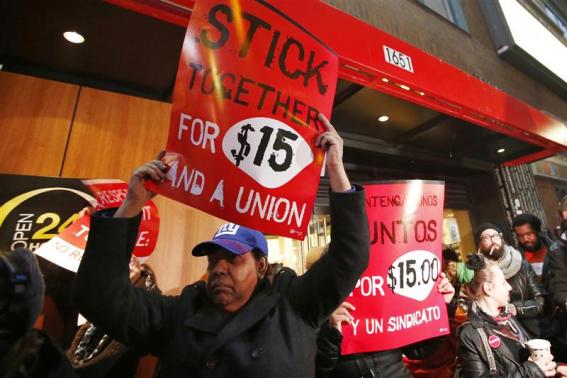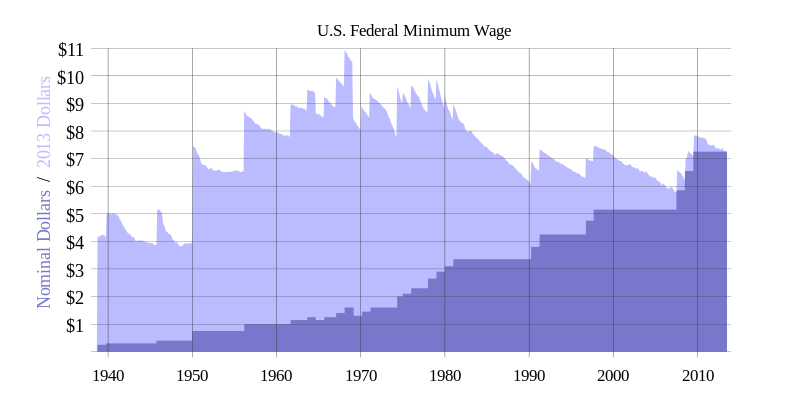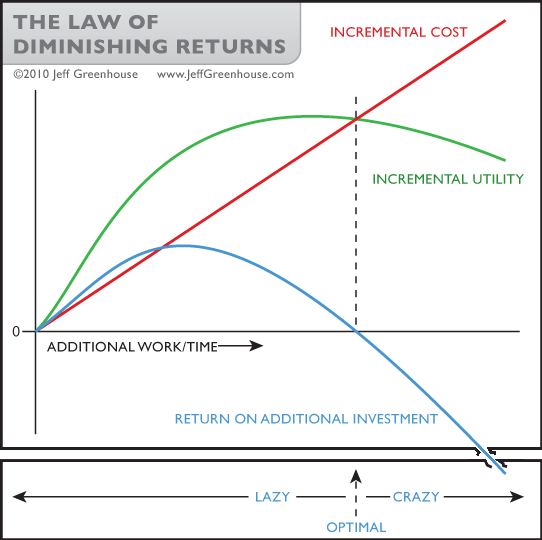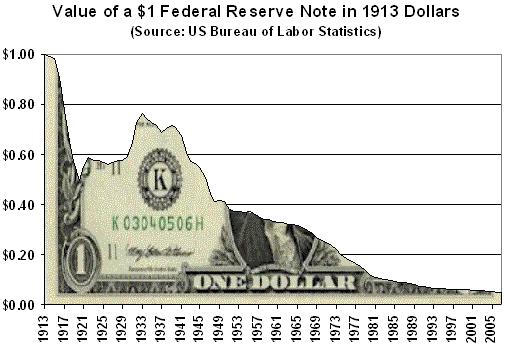January 14, 2014

Obama’s Part-time Economy and the Minimum Wage Push
original article written by Net Advisor
WASHINGTON DC. It used to be that 40-hours a week was considered a full-time job. The “Affordable Care Act” aka “Obamacare,” changed the definition of a full-time job. Any employer who has 50 or more employees working 30 or more hours a week are considered “full-time” workers [Report, Point 9] [Chart].
Thus since President Obama signed his signature healthcare legislation, “ObamaCare” he reduced the definition of what a full-time job is by 25%.
[1] Many Americans Working Fewer Hours
Last month, the Bureau of Labor Statistics reported that the average work-week for all employees was 34.4 hours (p3). Based on historic standards, Americas are working less hours, thus will receive less pay. Less consumer income also means less taxes for the government, which means the government will have to borrow to fund all their programs.
[2] Most New Jobs Are Low Wage Jobs
One study by a progressive law organization said that the majority of new jobs are low paying jobs. We’ll, I didn’t go to law school (thought about it – a lot), but I have published similar findings discussing how most of the new jobs in President Obama’s economy tend to be low-wage jobs [2014 Report, Point 5; 2013 Report, Point 6; 2013 Report, Points 7&8; 2012 Report, Point 3].
This is not to say that companies are not paying their workers enough, it’s that the U.S. economy is not doing well enough to produce higher paying jobs.
[3] Twinkies: Obama’s New Manufacturing Job
When I think of a manufacturing jobs, I think of autoworkers, aerospace, and defense – all which pay pretty good income and benefits. To make us all believe in the economy fairly-tale, the Obama Administration seems to be re-writing the definition of what things mean. In order to boost the appearance in growth in manufacturing jobs, the Administration changed the definition.
The Obama Administration now considers someone who bakes Twinkies (otherwise food processing) as a “manufacturing job” [Report, Point 8].
Some argue that we need more laws to protect labor, pay and equal rights.
[4] Fair Labor, Equal Pay, and Equal Protection Laws Already Exist
While a number of organized socialist groups push for fair labor, equal pay and civil rights, the U.S. already addressed these concerns with the following three laws:
(1) Fair Labor Standards Act (1938) (Law reference)
(2) Equal Pay Act (1963) (Law reference)
(3) Civil Rights Act (1964) (Law Reference)
The Civil Rights Act of 1964 prohibits employers from discriminating pretty much against anything now. So the laws are already in place for equal protection, non-discrimination and equal pay. So all workers are protected equally already.
Equality is not what social left groups want. They want more (usually money) than what they are willing (or able) to deliver; and they want more than the market will provide. Since the economy isn’t strong enough to support high wages for low-skilled or unskilled labor, President Obama’s solution? Raise the minim wage.

[5] Minimum Wage Push
The Obama Administration has been pushing for higher minimum wage. In other words, what we will have based on the average work-week is getting more money for working less?
Scanning a bar-code at the check-out, washing dishes, serving water, or cooking French fries is not exactly skilled labor. These are more entry-level jobs to teach the basics of working in an industry.
Some have argued that raising the minimum wage is a boost to the economy. Well if that was true, then just put the minimum wage at $500.00 an hour and everyone would be wealthy, poverty would end, and we could all buy gold-plated urinals?

The U.S. has aggressively been raising the minimum wage in recent years and wages have increased historically (chart above). We are pretty much in-line with nominal (unadjusted for inflation), and inflation adjusted 2013 dollars for wages now.
Some have argued that they just can’t live on a minimum wage (which can differ per state). So low and unskilled labor are asking (demanding and protesting) that business should just pay them more money so they can live the lifestyle they feel they deserve. Generally, most minimum wage jobs are for low or unskilled labor, entry-level positions, often targeted for age 15 to early 20 something.
The fact that the U.S. now has people who are much older, with college degrees, and some in retirement working in low-wage jobs says something about the true picture of the economy.
[6] Consequences of Socialized Economies
When people try to socialize an economy, what happens is you end up with economies that look like France, Greece, Italy, Spain, or Europe in general – all – with high unemployment rates, high energy costs, lower standards of living, and high taxes compared to the USA as it is now (or used to be).
In other words, business can’t pay people, let alone high wages when consumers aren’t employed to buy products or services. Socialistic-style governments can’t dish out unlimited welfare when there are little taxes to collect. Borrowing money “forever” to pay people not to work or have other benefit or entitlement programs when the economy can’t afford it, will eventually put the economy in a death spiral where economic disaster collides with reality.
One example of economic disaster colliding with reality occurred in Cyprus. The government of Cyprus had so much debt, along with reckless lending, high unemployment, and collapsing real-estate prices the country was technically insolvent.
The solution?
Government just seized cash from targeted customer’s bank accounts as a “one-time” tax, part of the EU bailout. This was like legal bank robbery of consumer cash all in the name of greater social welfare. The Cyprus government then put restrictions on how much money someone could take out from their own bank account [Report].
Instead of focusing on lowering taxes for consumers, business and making policies friendlier to business so they can grow then hire more people; the social left groups aren’t interested in economics, or reality; they just demand that you have to give them more of what you have.
The U.S. government has attempted to mitigate some of these issues over the last 50 years of people living in poverty. Despite trillions spent in welfare and anti-poverty programs, the U.S. has more people living in poverty today than ever before [Report].
[7] What Happens When Higher Wages, Taxes or Costly Regulations Forced on Business
When there is an increase cost to business, at least one of the following tends to happen:
- The business reduces the number of hours worked to off-set the cost increase [Report, Point 8].
- The business reduces the work force to off-set the cost increase.
- The business moves some or all of the labor costs to where labor is cheaper [Report, Point 6]. Results in unemployment at the local level. So forget about minimum wage, how about no wage with no job?
- The business reduces healthcare or other employee benefit programs to off-set the cost increase [Report].
- The business reduces the product size, volume, quantity, etc., or service for roughly the same price to off-set the cost increase.
- The business increases the costs to consumers to off-set the cost increase.
- The business goes out of business when it can no longer keep up with costs burdens.
Notice in ALL cases, the business has to take action to off-set the increase in costs. If, say a company has a payroll of $1 million a year, and has profits of $250,000 a year. Then the business is required by law to increase that payroll by say a 30% increase in wages, is the business still making money? No, the business is now losing $50,000 a year.
After 10 years of this, with growth being about the same, and doing nothing to offset the cost increase(s), the business has lost $500,000. How many years can a business take on debt to support wages it can’t afford without pricing itself out of the market? Answer: Zero. The business will immediately make adjustments so it can survive.
This model also impacts government. In North Carolina, the unemployment rate went DOWN from 9.4% to 7.4% after the state reduced unemployment benefits. This was the largest drop in the unemployment rate from 2012-2013 in the USA.

[8] Econ 101: Law of Diminishing Returns
In economic there is something called the law of diminishing returns (chart above). There becomes a point where no further benefit is created – and could cause harm in some cases.
Examples:
1. Have you ever studied past the point you were so tired that you just couldn’t think straight? You reached a point where more effort does not produce greater benefit.
2. Have you ever watered a plant to make it grow? Why not put 500 gallons of water in that plant, shouldn’t that make it grow more right? Of course not. Why? There is a point where the plant receives too much water that it can handle and what was thought something vital for the plant can actually kill it.
This is not to say we have to cut the minimum wage, just know that if business margins get squeezed too much, they may find it more economically viable to move elsewhere. The minimum wage in China is $2.38 in the big manufacturing Guangdong Province or Mexico about $4.18 hr.
[9] U.S. Growth Rate Far Behind China and Mexico
The annual growth in China (8.04%) and Mexico (3.5%) are doing better than the growth in the U.S.A (1.85%). Although the U.S. is the world’s largest economy at the moment, Mexico is growing almost twice as fast as the United States [See our 2012 Chart, Point 4]. In fact Mexico has a substantially lower unemployment rate than the USA in at least the last 10 years.
Despite Obama’s push for minimum wage, a recent report suggests the Obamacare employer mandate will increase the costs to employ a single hourly person by $2.24 an hour. Other views and reports by the non-profit think tanks, Cato and Brookings Institutes offered their studies. Despite everything we have said, fourteen states have already increased their minimum wage laws for 2014.
[10] Debunking the Low-Wage Wal-Mart Myth
Wal-Mart will probably love me after reporting this, but it’s nothing that I did but research the facts. There have been many public protests over recent years falsely arguing that companies such as Wal-Mart don’t pay their employees well.
A number of retailers tend to pay above minimum wage for unskilled labor such as Wal-Mart. A simple search of the company’s own data pulled 16 states (page 1 of 355 pages) where the lowest average wage for a full-time employee was $11.66 / hour (Delaware).
The highest full-time average wage was North Dakota at $14.42 hour because there aren’t enough workers to fill all the jobs needed in that state. When one adds Wal-Mart’s benefits such as healthcare, dental, pharmacy, disability, and retirement plan, the cost value can add up well above Wal-Mart’s current wages. Wal-Mart also guarantees all veterans a job (PDF).

[11] What is Really Killing Wages
If you want to know what’s really killing wages we can look right at the top. Wall Street? Nope. Try the U.S. government and the Federal Reserve. The more money the FED prints up that is not actually earned decreases the value of the U.S. currency. The more money the U.S. government spends in terms of deficits, decreases the value of the U.S. currency.
The U.S. Dollar has been declining in value due to government deficit spending and coincidentally ever since the creation of the Federal Reserve on December 23, 1913.
— Source: U.S. Bureau of Labor Statistics (Dollar Chart above)
The last time the U.S. dollar was worth a dollar was in 1913 – the same year the FED was created. In 2012, it now takes $23.27 to equal what $1.00 could buy back in 1913. Thus all this deficit spending and welfare is actually hurting the poor, the middle-class, everyone; as it takes more dollars to buy the same thing it did long ago.
If the U.S. government had balanced budgets, perhaps remove the FED, created a real – not projected surplus in material revenue without massive taxes and fees, then you can see the dollar strengthen and America’s buying power increase again. The only problem is the U.S. government doesn’t want a strong dollar because it makes goods we sell outside the USA more expensive.
[12] Higher Wages Exist Where the Economy is Booming
North Dakota currently has the lowest unemployment rate in the USA at 2.6 percent. One report shows that a McDonald’s in North Dakota is paying $17 an hour because there is a shortage of workers. The growth in the state has been booming because of the decision to drill its own existing domestic energy. The state is reportedly sitting on over 3 billion barrels of oil.
I checked to see who is running the state and it is Governor John “Jack” Stewart Dalrymple, III, a Republican. I also checked who is running the North Dakota state House and Senate. As of 2013 (the 63rd Legislative Assembly) the House and Senate are controlled by Republicans.
It’s pretty amazing what kinds of higher paying jobs the U.S. can create when we have leadership in place willing to use our energy resources instead of importing them from countries where many have a less-than-favorable opinion of the U.S.
So now we have many examples of basic economics of what works and what doesn’t work. Protesting for higher than minimum wages by low or unskilled labor when the economy can’t support that ultimately will hurt those who demand it. The key is government fiscal responsibility, and reducing costs burdens on business so they can thrive. When a business grows, they hire more people. When a business needs more workers and can’t get it, they increase wages to whatever price the economic environment demands such as the case in North Dakota.
original article content, Copyright © 2014 NetAdvisor.org® All Rights Reserved.
NetAdvisor.org® is a non-profit organization providing public education and analysis primarily on the U.S. financial markets, personal finance and analysis with a transparent look into U.S. public policy. We also perform and report on financial investigations to help protect the public interest. Read More.



